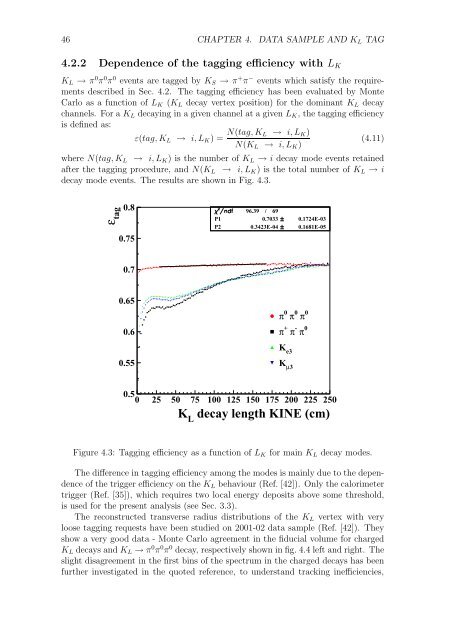Universit`a degli studi Roma Tre Measurement of the KL meson ...
Universit`a degli studi Roma Tre Measurement of the KL meson ...
Universit`a degli studi Roma Tre Measurement of the KL meson ...
You also want an ePaper? Increase the reach of your titles
YUMPU automatically turns print PDFs into web optimized ePapers that Google loves.
46 CHAPTER 4. DATA SAMPLE AND <strong>KL</strong> TAG<br />
4.2.2 Dependence <strong>of</strong> <strong>the</strong> tagging efficiency with LK<br />
<strong>KL</strong> → π 0 π 0 π 0 events are tagged by KS → π + π − events which satisfy <strong>the</strong> requirements<br />
described in Sec. 4.2. The tagging efficiency has been evaluated by Monte<br />
Carlo as a function <strong>of</strong> LK (<strong>KL</strong> decay vertex position) for <strong>the</strong> dominant <strong>KL</strong> decay<br />
channels. For a <strong>KL</strong> decaying in a given channel at a given LK, <strong>the</strong> tagging efficiency<br />
is defined as:<br />
ε(tag, <strong>KL</strong> → i, LK) = N(tag, <strong>KL</strong> → i, LK)<br />
N(<strong>KL</strong> → i, LK)<br />
(4.11)<br />
where N(tag, <strong>KL</strong> → i, LK) is <strong>the</strong> number <strong>of</strong> <strong>KL</strong> → i decay mode events retained<br />
after <strong>the</strong> tagging procedure, and N(<strong>KL</strong> → i, LK) is <strong>the</strong> total number <strong>of</strong> <strong>KL</strong> → i<br />
decay mode events. The results are shown in Fig. 4.3.<br />
ε tag<br />
0.8<br />
0.75<br />
0.7<br />
0.65<br />
0.6<br />
0.55<br />
0.5<br />
96.39 / 69<br />
P1 0.7033 0.1724E-03<br />
P2 0.3423E-04 0.1681E-05<br />
π 0 π 0 π 0<br />
π + π - π 0<br />
K e3<br />
K μ3<br />
0 25 50 75 100 125 150 175 200 225 250<br />
K L decay length KINE (cm)<br />
Figure 4.3: Tagging efficiency as a function <strong>of</strong> LK for main <strong>KL</strong> decay modes.<br />
The difference in tagging efficiency among <strong>the</strong> modes is mainly due to <strong>the</strong> dependence<br />
<strong>of</strong> <strong>the</strong> trigger efficiency on <strong>the</strong> <strong>KL</strong> behaviour (Ref. [42]). Only <strong>the</strong> calorimeter<br />
trigger (Ref. [35]), which requires two local energy deposits above some threshold,<br />
is used for <strong>the</strong> present analysis (see Sec. 3.3).<br />
The reconstructed transverse radius distributions <strong>of</strong> <strong>the</strong> <strong>KL</strong> vertex with very<br />
loose tagging requests have been <strong>studi</strong>ed on 2001-02 data sample (Ref. [42]). They<br />
show a very good data - Monte Carlo agreement in <strong>the</strong> fiducial volume for charged<br />
<strong>KL</strong> decays and <strong>KL</strong> → π 0 π 0 π 0 decay, respectively shown in fig. 4.4 left and right. The<br />
slight disagreement in <strong>the</strong> first bins <strong>of</strong> <strong>the</strong> spectrum in <strong>the</strong> charged decays has been<br />
fur<strong>the</strong>r investigated in <strong>the</strong> quoted reference, to understand tracking inefficiencies,
















